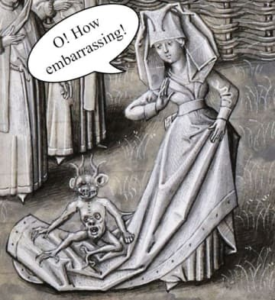Menstruation in Tudor Times
How did Tudor Women Cope with the Physical, Religious, and Moral Expectations?
It has been happening to women since the dawn of time and yet, during the Tudor age, society rarely spoke of it. Known as the monthly curse, coming of age, or period, menstruation has been referred to, across the ages, by many different terms. During this time in history, Christianity preached that a woman’s period existed as a punishment from God for Eve’s temptation in the Garden of Eden. Leviticus stated that a woman who menstruates is impure and unclean. As a result, the Church prohibited painkillers for menstrual pain relief, as women supposedly deserved to suffer the cramps and pains given to them by God. Additionally, the Church also declared that women should refrain from receiving Holy Communion during this bloody time. The Church expected women to do nothing but suffer during their “time of the month”.
 Henry VIII’s first wife, Catherine of Aragon, suffered from inconsistent periods throughout her life. As a result, this fact combined with her apparent inability to deliver the King a healthy son, resulted in divorce and her untimely death, possibly brought on by deliberate poisoning. In this extremely sad case, her “faulty” reproductive system literally led to both her royal and actual downfall. However, rather than blaming her reproductive system, or the sperm of her husband, the Church, as well as her husband, blamed Catherine’s personal character and the existence of a previous marriage. These perceived moral downfalls led to her failures, and not the whims of mother nature, according to the Church and Tudor society.
Henry VIII’s first wife, Catherine of Aragon, suffered from inconsistent periods throughout her life. As a result, this fact combined with her apparent inability to deliver the King a healthy son, resulted in divorce and her untimely death, possibly brought on by deliberate poisoning. In this extremely sad case, her “faulty” reproductive system literally led to both her royal and actual downfall. However, rather than blaming her reproductive system, or the sperm of her husband, the Church, as well as her husband, blamed Catherine’s personal character and the existence of a previous marriage. These perceived moral downfalls led to her failures, and not the whims of mother nature, according to the Church and Tudor society.
 The Tudor era consisted of a variety of wild and unsubstantiated claims regarding the blood of menstruation. For example, some individuals believed in the inherently dangerous and poisonous nature of women’s menstrual blood. Many believed that the absence of a bleeding womb could lead to the body becoming overrun with blood, potentially drowning the woman. Some believed that menstrual blood would cause harm to a man’s sexual member and also children conceived during menstruation would be born with red hair and suffer various deformities. While not everyone during these times held these nonsensical beliefs, they nevertheless publicly agreed with the primary viewpoint held by the Roman Catholic, and later the Anglican Church.
The Tudor era consisted of a variety of wild and unsubstantiated claims regarding the blood of menstruation. For example, some individuals believed in the inherently dangerous and poisonous nature of women’s menstrual blood. Many believed that the absence of a bleeding womb could lead to the body becoming overrun with blood, potentially drowning the woman. Some believed that menstrual blood would cause harm to a man’s sexual member and also children conceived during menstruation would be born with red hair and suffer various deformities. While not everyone during these times held these nonsensical beliefs, they nevertheless publicly agreed with the primary viewpoint held by the Roman Catholic, and later the Anglican Church.
 Thankfully, despite such orders from the Church, Tudor women often devised a variety of herbal remedies for the easement of pain. Such remedies included hot herbal baths, herbs placed into the vagina, and drinking herbs such as rue. These women, utilizing their cleverness, developed the first sort of “period” protection in the form of household rags made of cotton or wool bundled together and placed between the legs. Depending on a person’s status and access to such materials, Tudor women often washed and reused these rags. Unfortunately, there is little evidence to suggest what exactly held these cloths in place. However, it has been suggested that women of this age wore some form of girdle or rough underwear.
Thankfully, despite such orders from the Church, Tudor women often devised a variety of herbal remedies for the easement of pain. Such remedies included hot herbal baths, herbs placed into the vagina, and drinking herbs such as rue. These women, utilizing their cleverness, developed the first sort of “period” protection in the form of household rags made of cotton or wool bundled together and placed between the legs. Depending on a person’s status and access to such materials, Tudor women often washed and reused these rags. Unfortunately, there is little evidence to suggest what exactly held these cloths in place. However, it has been suggested that women of this age wore some form of girdle or rough underwear.
The onset of menstruation for many young women during the Tudor age consisted of the time when society acknowledged their transformation from young girls into womanhood. It is interesting to note that the age of consent for the time, approximately twelve to fourteen years of age, coincided with the average onset of menstruation.
Menstruation, although taboo during the Tudor age, nevertheless constituted a very common occurrence. Tudor society expected all females to get their periods, experience them regularly and to subsequently have the ability to conceive a healthy child. The inability to do so constituted, on the part of the woman, a serious religious and moral failure. Although rarely spoken of, the menstrual cycle, nevertheless, represented a very important part of Tudor society.




Leave a Reply
Want to join the discussion?Feel free to contribute!